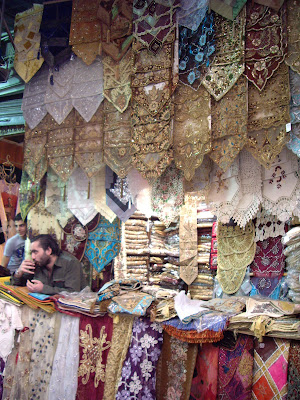So, just how old is the city of Damascus?
Truthfully, at first, I thought maybe it is more than a thousand years old. Then I found out later, according to my good friend Google, the city has been around since 6300 BC. Other findings suggest that it dates as far back as 9000 BC! Mind boggling, my imagination is stumped.
Historians do generally agree that Damascus is the oldest continuously inhabited city in the world.
We stayed at a few minutes walk from the Old City area - which made walking to the main bazaar, Souq Al Hamediyya, a breeze.
UNESCO World Heritage Site status accorded in 1979.
Landmarks and signages.
Souq Al- Hamediyya, the main souq/bazaar. It's a looong walk to the other end.

As with other Middle Eastern souqs, there are many many many things on sale. From clothing and footwear to fabrics and crafts and of course, souvenirs for tourists. Many Arab tourists - from Lebanon, Jordan - flock to Syria to shop because it is the cheapest country in the neighbourhood. We likened it to our own MY-SG relationship :)
Statue of Salladin near the Citadel entrance.

Covered ladies - there's many and I learnt about the differences in how their cover-up or wear their robes/veils.
Tea seller at the entrance of the Souq.
Sand art in bottles. They're really skilled.
What are these? Fridge magnets.
View of The Western Gate.
A beautiful courtyard restaurant - it didn't look much from the outside though. This one had some sort of royal recognition at the door.
Flat breads are baked in a traditional oven.
Shisha/nargileh/hookah paraphernalia sold from a 'sunken' (below road level) shop lot. Never tried it - I can't get my head around the hygiene issue.

At the other side of the city, you can see a mixture of old and new. Some old buildings are left to rot. Literally.
The walls looked like they're made of mud, wood and straw.
Al-Merjeh - Martyr's Square. A landmark that is quite close to the backpackers' favoured area. Apparently the immediate area is city's red light area too?

The National Museum is closed on Tuesdays. Duh. But we did spend time at another building across which had the Silk Road Festival 2010 Exhibition.
This outdoor area displayed bits of ruins and other artefacts was closed off for some upgrading/restoration work.
I enjoyed the Silk Road Exhibition - small and simple, yet interesting. And because they had things to sell that we can buy :)
Another beautiful cosy courtyard - at the Al Rabie Hotel. If you want to stay at a place with character, this is a good choice. A backpackers' haunt, thanks to LP. We did not stay here as it was beyond our budget. Peak season.

I am guessing that these are bits of ruins; instead of putting them back together they are simply arranged as part of the landscape decorations along the road.

I love this white gate and its columns that indicates that you have arrived at the Christian Quarter.
Anyway, Damascus is not all old-city. On the 3rd day, our kind driver brought us up Mount Qaissoun to enjoy the sunset, and, oh boy, the view was awesome! The city is freaking huge, and we totally did not venture to the more modern parts. And the sight of this mountain at night? Like a whole mountainside covered in fairy lights! Unfortunately I did not manage to capture this with my camera, I think a fancy camera (read : DLSR) is needed!
Time to save for a new toy, perhaps?























u definitely need a new camera Aud. Night shots should be in anyone's collection of photos. :-) I like the way they do the pavement on the Medhat Pashat. Or, and why is it called Christian Quarter?
ReplyDeleteYa, I do need one, and that means I need to start saving for one! :)
ReplyDeleteChristian Quarter - where most of the old churches are located and most of the Christians live there, but there is a mosque there too. There is also a Jewish Quarter.
I'm not surprised it's old, in fact most of Middle East is old old - prophets used to roam the region, right.
ReplyDelete